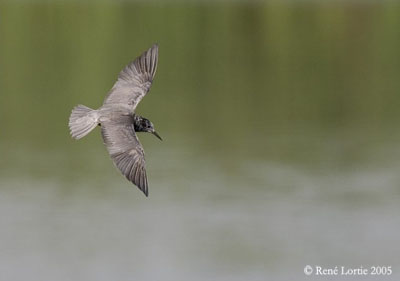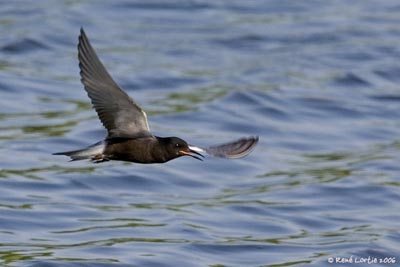
Fr: Guifette noire
All : Trauerseeschwalbe
Esp : Fumarel Común
Ital: Mignattino
Nd: Zwarte Stern
Sd: Svarttärna
Photographers:
Tom Grey
Tom Grey's Bird Pictures
Patrick Ingremeau
TAMANDUA
René Lortie
http://rlortie.ca
Nicole Bouglouan
PHOTOGRAPHIC RAMBLE
Text by Nicole Bouglouan
Sources:
HANDBOOK OF THE BIRDS OF THE WORLD Volume 3 by Josep del Hoyo-Andrew Elliott-Jordi Sargatal - Lynx Edicions - ISBN : 8487334202
THE HANDBOOK OF BIRD IDENTIFICATION FOR EUROPE AND THE WESTERN PALEARCTIC by Mark Beaman, Steve Madge - C.Helm - ISBN: 0713639601
A GUIDE TO THE BIRDS OF MEXICO AND NORTHERN CENTRAL AMERICA by Steve N. G. Howell, Sophie Webb - Oxford University Press - ISBN: 0198540124
ENCYCLOPEDIE DES OISEAUX DE FRANCE ET D’EUROPE – de Peter Hayman et Rob Hume - Flammarion – ISBN : 2082009920
BirdLife International (BirdLife International)
Bird Web (Seattle Audubon Society)
Animal Diversity Web (University of Michigan Museum of Zoology)
What Bird-The ultimate Bird Guide (Mitchell Waite)
Black Tern
Chlidonias niger
Charadriiforme Order – Laridae Family
BIOMETRICS:
Length: 23-28 cm
Wingspan: 57-65 cm
Weight: 60-74 g
DESCRIPTION:
The Black tern is a small dark tern, very graceful when feeding at water surface.
Adult male has dark slaty grey back. Upperwing and tail are grey.
On the underparts, chin, throat and breast are black. Belly is dark slaty grey. Vent and undertail coverts are white. Underwing is pale grey.
Head and neck are black. Bill is black. Eyes are dark brown. Legs and feet are blackish-red.

Female is slightly different. She is greyer with dull black crown.
The Black Tern in non-breeding plumage is pale grey above and white below, with dark patch on the breast side. Head is white with blackish central crown joining the black patch behind the eye. There is also a dark spot in front of the eye.
The juvenile is similar to non-breeding adult, with pale brown forehead and grey-brown scapulars and back, with buff edges.
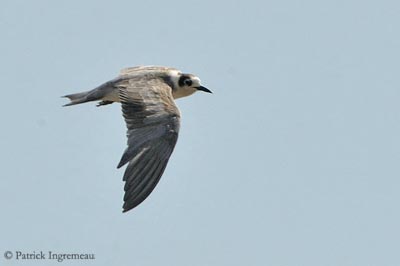
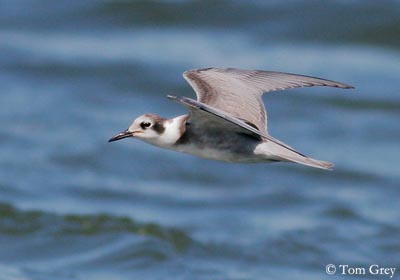
We find two subspecies:
C.n. niger, from the Old World.
C.n. surinamensis is smaller and darker. In non-breeding plumage, adult and juvenile show pale streaks on the dark crown, and larger blackish patch on breast side. This one occurs in the Americas.
VOICE: SOUNDS BY XENO-CANTO
The Black Tern utters a piping, slightly high-pitched “peep” or “pseeh”. The birds feeding in flocks give some “kriih”.
The alarm call is a quacking “kek”, frequently given if intruders approach the nest.
The usual call is a weak, sharp “kik” or “kik-kik”, and a short shrill “kyeh”.
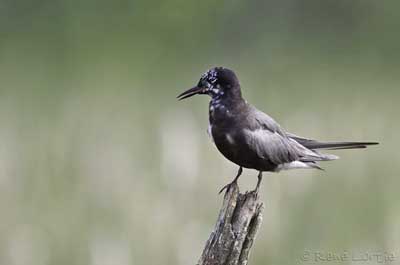
HABITAT:
The Black Tern breeds on inland waters such as marshes, pools, lakes or ricefields with dense cattail and marsh vegetation, but also with open water areas.
During winter, this species lives mostly offshore, but also on the seacoast, in estuaries and coastal lagoons.
During the migrations, it is often seen on coasts and estuaries, but also at any wet area, ponds and even ditches.
RANGE:
The Black Tern subspecies “niger” occurs in Europe and Western Asia, and winters on African Atlantic coasts.
The subspecies “surinamensis” occurs in North America, and winters on the northern coasts of South America, Pacific coasts of California and both Pacific and Atlantic coasts of Central America.
They migrate in flocks and perform stopovers on lakes and lagoons.
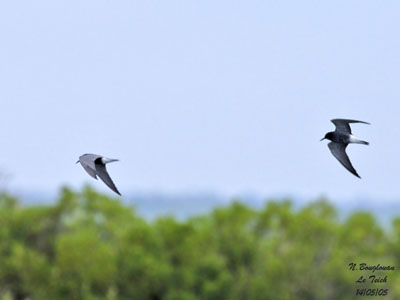
BEHAVIOUR:
The Black Tern feeds on aquatic insects and small fish, frogs, tadpoles and snails. This tern rarely dives as numerous other tern species do, but feeds by contact-dipping and hover-dipping, and by hawking insects.
It flies low over the feeding area, and then, swoops to the surface. According to the area, the tern dips the bill into the water or picks insects off vegetation.
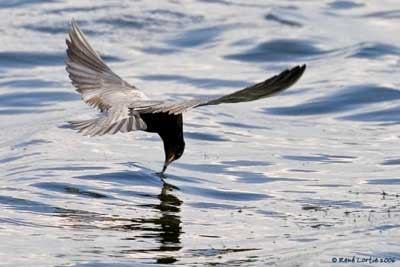
The Black Tern feeds mainly on insects during the breeding and nesting seasons, whereas in winter, it favours small fish.
During the breeding season, we can observe some displays. The pairs fly over the colony at some height and in flocks. During these displays, the flight is jerky. Then, the first pair glides down and leaves the others behind. Males often fly with fish in the bill in order to attract females.
During the nesting period, the male feeds the female at nest.
This species is gregarious all year round.
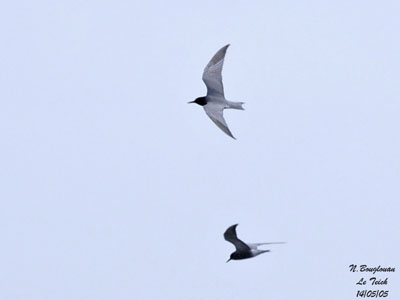
FLIGHT:
The Black Tern performs light and erratic flight when feeding by contact-dipping over lakes and marshes.
They migrate at a great height, performing full and steady wing-beats.
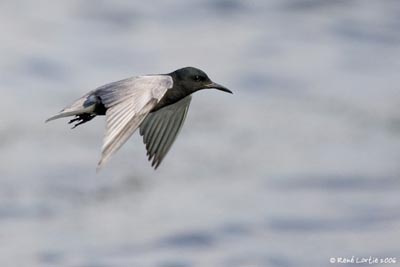
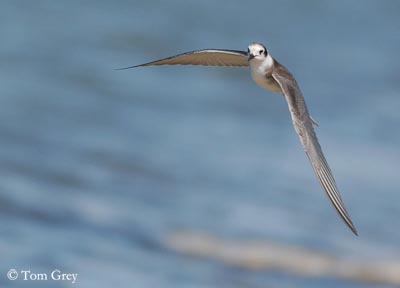
REPRODUCTION:
Breeding season occurs in May-June both in Europe and North America.
The Black Tern favours marshes with floating vegetation for nesting. This species nests in small colonies of usually about 20 pairs, rarely more than 100 pairs. It nests often over water of at least 50 cm depth, but also on houses, in old nests of coots or grebes, boards…
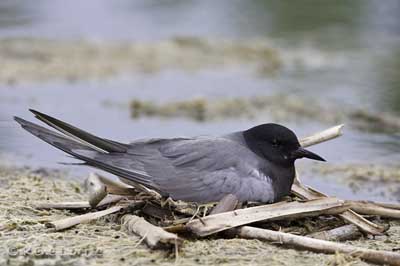
In North America, they breed in low, wet areas, and the nests are usually more than three metres apart, but often 20/100 metres according to the place.
The nest is an assemblage of floating vegetation, dead reeds or cattails, built by both adults.
Female lays 2-3 whitish spotted brown eggs. Incubation lasts about three weeks. If the parents are disturbed by an intruder, they leave the nest but they do not mob.

Predation is highest in small colonies, mainly by muskrats, but also by pigs at low water level. Nests are also lost through storms and waves action.
The chicks may leave the nest after 2-3 days, but they remain in close vicinity. They crouch on the ground or in the nest, waiting for the food brought by their parents. Sometimes, the third chick is smaller and competition for food with its stronger siblings is hard, and the survival is usually low.
Chicks fledge and can fly about 23 days after hatching, but they depend on parents for food for up to two weeks more.
This species produces one brood per year, rarely two.
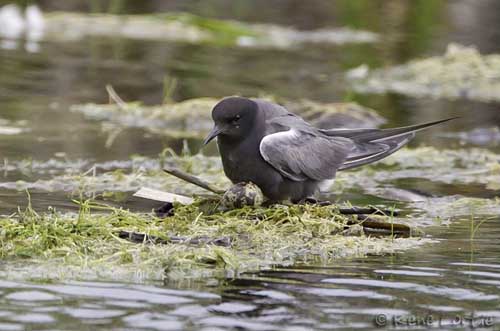
DIET:
The Black Tern feeds primarily on insects during the breeding season (Coleopteran, Odonata and Ephemeridae). Outside the nesting period, it feeds also on small fish and aquatic animals such as tadpoles, frogs and snails. During the migration, they feed mainly on fish, but they also consume insects and crustaceans.
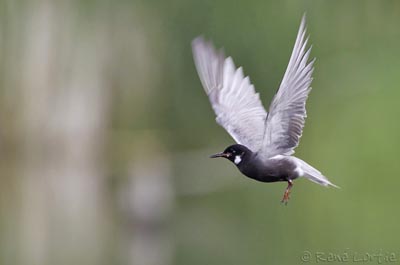
PROTECTION / THREATS / STATUS:
The Black Tern’s populations are vulnerable or declining locally, due to drainage of freshwater marshy habitat for agriculture, and human disturbances. Predation at nest is common by muskrats and also by pigs when water level is low.
Reduction of food availability due to eutrophication of water, acidification of lakes, introduction of exotic fish species and pollution by pesticides are some of the main threats.
However, the Black Tern is not threatened at this moment.
